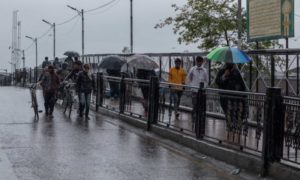New Delhi: After conducting what is being described as one of the largest analysis of COVID epidemiology to date, researchers in India – including those from the Government of Tamil Nadu, and Andhra Pradesh have found that both cases and deaths due to the disease in India have been more heavily concentrated in the 40-69 year age group than in high-income countries, among other trends.
The study, published in the journal Science on Wednesday, analyses the disease transmission patterns in 5,75,071 individuals exposed to 84,965 confirmed cases of COVID in the two Indian states based on data collected by tens of thousands of contact tracers, Hindustan Times reported.
According to the scientists, including Ramanan Laxminarayan from the Center for Disease Dynamics, Economics, and Policy in New Delhi, the findings offer a “peek into the pandemic’s trajectory in a low- and middle-income country”, where most COVID cases have occurred.
Both cases and deaths, the scientists said, based on data in the two Indian states were “concentrated in younger cohorts” than expected from “observations in higher-income countries”.
The study also noted that contacts with the same age were associated with the greatest infection risk — a pattern, which the researchers said, was ‘strongest among children between 0-14 years of age, and among adults older than 65 years’.
The study categorises contacts into high and low risk. Those who shared a household with the index case had a contact at less than one-metre distance without protective equipment, and travelled in the same shared mode of transport within three rows of the index case were classified as high-risk contacts. Over 10% of such contacts of index cases tested positive, meaning that they had a one in ten chance of being infected. On the other hand, people who shared the same space with an index case without meeting these high-risk contact criteria were categorized as low risk.
They said the proportion of deaths to the number of infected people, known as the case-fatality ratio (CFR), spanned 0.05 per cent at ages 5-17 years to 16.6 per cent at ages exceeding 85.
The age group most likely to result in spreading infections is the 20-44 age groups, the study found. Children also play a significant role in the spread of infections, the study shows.
“We found that children transmit to each other, and to the elderly,” said Laxminarayan. This finding is particularly of concern since most infections in children are mild, and are likely to be undiagnosed.
“This is consistent with what we know about influenza, where children are among the primary drivers of the infections; it should not be surprising to see this in respiratory infection,” the report quoted Kang as having said.
The researchers also noted that COVID patients in the two Indian states have a median stay of five days in the hospital before death compared to 13 days to die from the date of hospital admission in the US.
Follow-up testing of exposed contacts revealed that 70 per cent of infected individuals did not infect any of their contacts, while 8 per cent of coronavirus positive patients accounted for 60 per cent of observed new infections.
The researchers said this finding presents the largest empirical demonstration of super spreading. They said the findings “may indicate the identification of less-severe infections through active case-finding.”
Andhra Pradesh and Tamil Nadu are among the Indian states with the largest healthcare workforce and public health expenditures per capita, and are known for their effective primary healthcare delivery models, the study noted.
It said 63 per cent of those who died had at least one co-morbidity, and 36 per cent had two or more underlying health conditions that made them more susceptible to the disease. About 45 per cent of those who died were diabetic, the scientists said.
They said the deaths in India, unlike observations in high-income countries, are concentrated at ages 50-64 years.
In the two Indian states, in particular, they said only 17.9 per cent of COVID-19 deaths occurring on or before 1st August 2020 was among people older than 75, compared with 58.1 per cent of deaths due to the disease in the US.
“This study was made possible by the significant contact tracing effort in Andhra Pradesh and Tamil Nadu, which involved tens of thousands of healthcare workers,” Laxminarayan said.
“The results on disease transmission and mortality have the potential to inform policy to fight COVID. The study also speaks to the capacity of research emerging from India to help inform the global response to the virus,” he added.
Free Press Kashmir is now on Telegram. Click here to Join.












